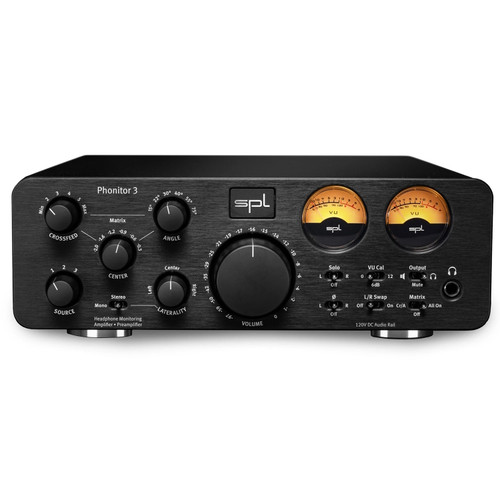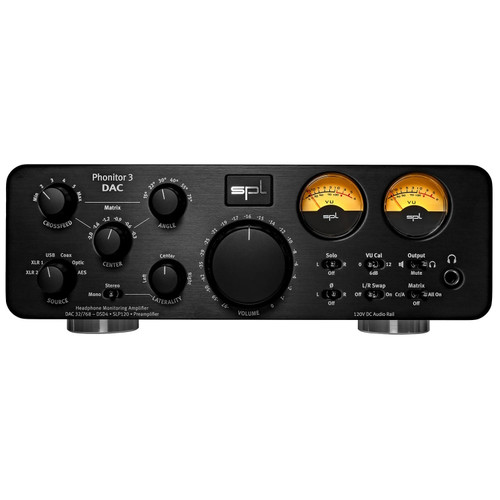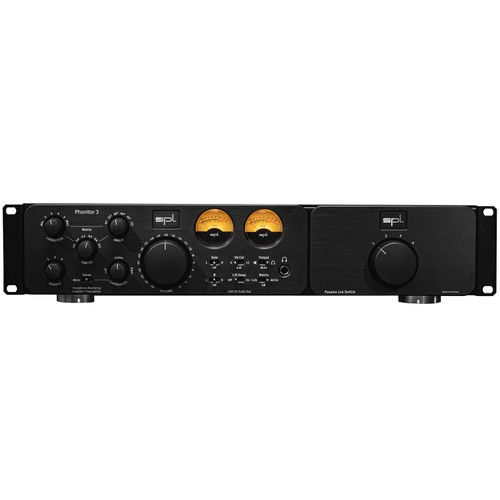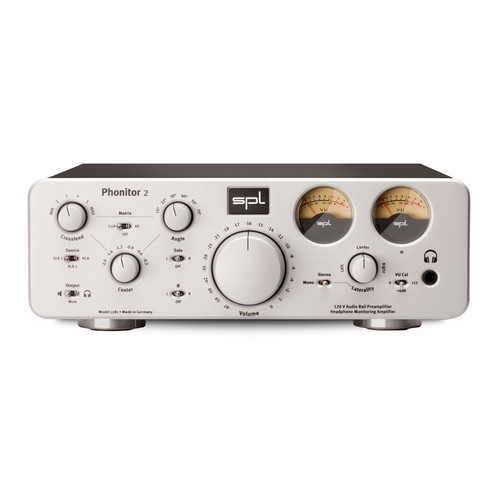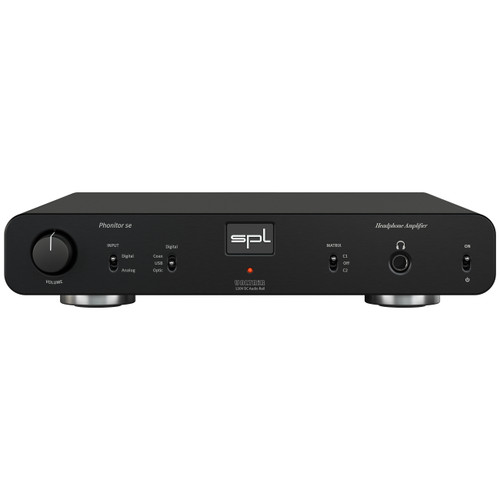The SPL Phonitor 3 is the ultimate headphone amplifier and monitoring controller with 120V technology. It offers the same monitoring quality as the big SPL mastering consoles – on loudspeakers and headphones. The analog Phonitor Matrix allows mixing and mastering on headphones in the highest quality with the same spatial perception of the stereo stage as on loudspeakers. Three analog XLR stereo inputs for various sources and a wide range of monitoring options make it the perfect monitor controller for demanding producers and mixing/mastering engineers.
THE ULTIMATE HEADPHONE AMPLIFIER AND MONITORING CONTROLLER
The Phonitor 3 offers connection for a standard headphone with a stereo jack plug on the front. Thanks to the enormous output power, all kind of headphones are driven effortlessly. Thus, it plays out the advantages of the SPL 120V technology and rewards the listener with an honest, detailed and at the same time vivid sound experience.
On the rear of the device, Phonitor 3 offers a stereo output which makes it a high-quality monitoring controller for any monitoring situation. Active speakers with an integrated power amplifier or passive speakers in combination with a power amplifier can be connected at this output. Phonitor 3 offers the same key technology – SPL 120V technology – and signal quality as the big SPL DMC and MMC mastering consoles. The Output switch allows you to simply switch from headphone to speaker playback. In the center position (Mute), no signal reaches the outputs. The VU meters light up red.
ANALOG INPUTS
Three analog stereo inputs are offered, each with two XLR line inputs (left channel, right channel). Professional analog players with balanced outputs and line level can be connected here, for example high-quality DA converters or an audio interface.
MILLED FROM SOLID ALUMINUM
The massive 45mm volume control knob milled from aluminum is a haptic highlight. Its mass together with the Alps RK27 “Big Blue” potentiometer enhances the “spoon in the honey” feeling even further and provides perfect control of the monitoring level.
MONITORING WITHOUT ANY COMPROMISES
The Phonitor 3 is a full-fledged monitor controller:
Source selection
- Phonitor Matrix with Crossfeed, Speaker Angle and Center Level (the latter can be switched off)
- Mono/Stereo
- Laterality control
- Solo L/R
- Phase inversion for L and R
- L/R Swap
- Output switchable to headphones or speakers
- Mute
- The Mono/Stereo switch can be used to select whether the output signal of the Phonitor 3 is a regular stereo signal or whether it is summed to a mono signal.
Naturally, hearing can be directed more to the left or more to the right. This becomes particularly clear when listening on headphones. Therefore, the Phonitor 3 has the uniquely finely resolved laterality control, which rebalances the stereo image on the monitoring side. The Mono/Stereo switch can not only be used to switch between stereo or mono playback. This switch is also used to activate or deactivate the laterality control.
Only the right or left channel of the audio signal should be played back? The Solo L/R function makes it possible. If the triple selection switch is in the “L” position, only the left channel is played back – if it is in the “R” position, only the right channel is played back. In the middle position “Off” the Solo function is switched off. The regular stereo signal consisting of the left and right channel is thus present at the output of the Phonitor 3.
A special feature is the channel swap function: L/R Swap. This function inverts the stereo image. Left becomes right and right becomes left. This is especially important and extremely time-saving, when you are monitoring samples in video dubbing that should match a scene with direction of movement. If the direction is not correct, you usually have to load the sample into the DAW to switch channels. before you can judge whether the sample matches the image. With the L/R Swap function, this is no longer necessary. You can now adjust the direction of movement on the Phonitor 3 while pre-listening the sample library.
With the L/R phase inversion switch the phase of the left or right channel of the audio signal can be inverted. If the three-way selection switch is in the “L” position, the left channel is inverted – if it is in the “R” position, the right channel is inverted. In the middle position “Off” this function is switched off. At the output of the Phonitor 3 the regular stereo signal is thus present.
By using the mono/stereo and L/R phase inversion switch in combination, it is also possible to only monitor the mid or side signal. When the switch is set to “Mono” and phase inversion is active for L (or R), only the side signal is played back. If the phase inversion is switched off, the mono signal corresponding to the “M” signal is played back. Separate monitoring of the M and S signals has become a widespread standard for many mixing and mastering engineers.
THE REVOLUTION: PHONITOR MATRIX
One of the unique features of SPL headphone amplifiers is the SPL Phonitor Matrix. It enables mixing and mastering engineers to create perfect mixes on headphones, which will translate perfectly to all types of stereo speaker systems. But the Phonitor Matrix is not only designed for professional use in the studio. It also enables the hifi enthusiast to enjoy music on headphones, like if it was played back on speakers.
120V TECHNOLOGY
The 120V technology works with ±60 V. To be able to handle such a high voltage, SPL have developed special proprietary operational amplifiers that can operate with a DC voltage of +/-60 V: the SPL 120V SUPRA operational amplifiers. This high voltage would destroy conventional components and operational amplifiers.
The 120V technology achieves exceptional technical specifications and sonic benefits. Technically, in terms of dynamic range, signal-to-noise ratio and headroom. Sonically, in terms of richness of detail and an absolutely relaxed listening experience.
By the way, the “120V” in the name of the technology has nothing to do with the local mains voltage from the mains power socket. This is about the operating voltage inside the device with which the audio signals are processed.
The mains voltage from the mains power socket is transformed to the required secondary voltage in the device ́s internal linear power supply with toroidal trans- former. Rectifiers convert this AC voltage into DC voltage required in the audio device.


